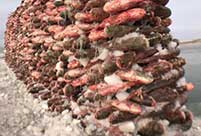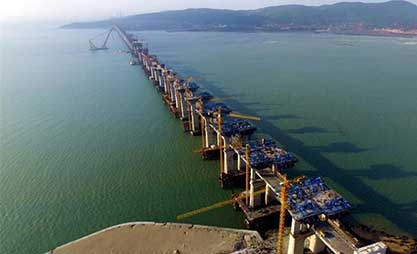

A Famous Historic City
Changsha, as a famous historic city, is richly endowed with beautiful scenery and has brought forward numerous men of talent. With its name and site unchanged over the past 3,000 years, Changsha has long been known as “Home of Qu Yuan (great patriotic poet) and Jia Yi (famous politician and litterateur)”, “City of Chu-Han Culture” and “Xiao Xiang Zhu Si (City of Scholars’ Gatherings)”, and the city has been listed in the first 24 famous historic and cultural cities released by the State Council.
Historic legacies such as Four-Sheep Square Statue, the Han Tombs at Mawangdui, Bamboo and Wooden Slips of Wu Kingdom (a state in the era of the Three Kingdoms), Yuelu Academy, and Tongguan Kiln could be found here; revolutionary heroes and patriots such as Tan Sitong, Huang Hsing, and Cai E, and party and state leaders such as Chairman Mao Zedong, Chairman Liu Shaoqi, and General Secretary Hu Yaobang were all emerged here; in a word, this place is the cradle of Chu-Han Culture and the source of Huxiang Culture.
A Resource-Saving and Environmentally Friendly City
Changsha provides people with high quality of life, and takes lead in building a resource-saving and environmentally friendly (hereinafter referred to as “two-oriented”) new city. With Yuelu Mountain standing in the west, Tianxin Pavilion overlooking the city, Xiangjiang River running through the city, Orange Island lying in the middle of Xiangjiang River, the city has formed a beautiful picture scroll with an integration of “mountains, rivers, islands, and city”. As the bellwether of Changsha-Zhuzhou-Xiangtan National Two-Oriented Social Construction Comprehensive Reform Pilot Area, the city has established an effective energy-conservation and emission-reduction mechanism, increased resource utilization rate significantly and improved ecological environment greatly; in addition, the resource-saving and environmentally friendly industrial structure, growth pattern and consumption pattern are taking shape.
Led by the concept of “two-oriented society”, Changsha has become a place where the forest coverage rate exceeds 54.8% and human and nature co-exist harmoniously. Hence it is awarded as “Green City” at the Global Forum of Human Settlement, and is listed in the first batch of national outstanding tourism cities and exemplary cities for ecological construction, further highlighting its unique landscape as a city integrated with mountains, rivers and islands.
A Creative City
Changsha is a creative city that pursues prominence. The Huxiang culture, an organic integration of pragmatism and inclusiveness, edifies the Changsha spirit of caring about the world and daring to achieve prominence, and helped the city in forging various cultural brands like “Hunan TV Group”, “Hunan Publishing Group”, “Hunan Cartoon Group” and “Hunan Entertainment Group”.
Changsha is among the first batch of National Animation & Game Revitalization Bases and National Culture-Technology Integration Demonstration Bases, and serves as the permanent host of China Golden Eagle TV Art Festival. Changsha is also honored one of the Culture City of East Asia in 2016. Teleplay masterpieces like Dream of Youth, Mao Zedong, Yongzheng Dynasty, etc. and flagship TV shows such as I am a Singer, Dad! Where are We Going? and Happy Camp have won universal praise and popularity.
A Happy City
Changsha is a happy city where people can enjoy their life and develop their career. The awareness of observing courtesy and decorum is rooted in the heart of every resident, making Changsha a National Culturally Advanced City, and the city has been honored as the Happiest City in China for 9 consecutive years. It has also won the blue ribbon “Chang’an Cup” in the national social management work evaluation.
The city has witnessed rising expenditure for people’s livelihood. In 2016, the city’s spending on people’s livelihood accounted for 79.5% of the spending of public finance budget. Social security has been enhanced, and transportation, health care, education, housing and other public services have been optimized. The city’s satisfaction rate of elementary education ranked the 4th in China, and the city has successfully established the first national public culture service system demonstration area.
A Developing City
Changsha is a hot land of economic transformation and innovative development. As the core growth pole of “One Belt and One Road” (transitional belt of eastern coastal region and central and western regions and junction of Yangtze River economic belt and coastal economic belt) as well as the important pivot of city cluster alongside the middle reaches of Yangtze River, it boasts advantageous location, advanced transportation and prosperous logistics. The high speed railway lines of Beijing-Guangzhou, Shanghai-Kunming run across Changsha, making it an important high-speed railway hub, and the Huanghua International Airport ranks first in the central region in terms of passenger throughput. In May of 2016, Changsha Maglev Rail opens for trial operation-China’s first home-made middle and low speed Maglev railway.
In 2016, the city’s economic aggregate reached 932.37 billion yuan. Changsha County, Liuyang City and Ningxiang County within its jurisdiction are all among China's Top 40 Counties in terms of basic competitive power. Engineering machinery, auto and auto parts, material industry, electronic information, and food industry of the city develop with a steady pace and emerging industries, such as mobile Internet, integrated circuit, industrial robot, housing industry, and Beidou navigation satellite system, show a strong momentum. Technological innovations including super hybrid rice, Tianhe-2 Super Computer and 3D printing are driving forward the economy. Changsha was successively rewarded as one of the Top 10 Chinese Innovative Cities, National Exemplary City of Intellectual Property and China Sustainable City.
Located in the west bank of Xiangjiang River, Hunan Xiangjiang New Area was the first national new area in central China, and aims to be an integration area of high-end manufacturing research and development base and innovative and creative industries, a new urbanization demonstration area of city-industry integration, and urban- rural integration, a leading area of “Two-Oriented” society building, and a highland for the openness of inland areas of Yangtze River Economic Zone.
According to the comprehensive development in all five fronts with four major tasks, guided by the philosophy of innovation, coordination, green development, opening-up and sharing, Changsha is pressing ahead with the innovation-driven opening up strategy by building a National Intelligent Manufacturing Center, a National Center for Innovation and Creation, and a National Transportation and Logistics Center. Together, we strive to build Changsha a modernized central city of China with greater power, strength, landscape and well-being for its people。
 Fishermen build wall with 2,000 fish in Jilin
Fishermen build wall with 2,000 fish in Jilin In pics: Americans in 2017
In pics: Americans in 2017 In pics: Longzhou Danxia landform in NW China
In pics: Longzhou Danxia landform in NW China China's "four great new inventions" in modern times
China's "four great new inventions" in modern times Chinese brand becomes largest handset provider in Africa
Chinese brand becomes largest handset provider in Africa Busty Lais Ribeiro steals the Victoria's Secret Fashion Show
Busty Lais Ribeiro steals the Victoria's Secret Fashion Show Highlights Victoria's Secret Fashion Show in Shanghai
Highlights Victoria's Secret Fashion Show in Shanghai China's first cross-sea rail-road bridge takes shape
China's first cross-sea rail-road bridge takes shape A fancy world painted on fallen leaves
A fancy world painted on fallen leaves Top 10 most sustainable cities in China
Top 10 most sustainable cities in China Top 10 European patent applicants in 2016
Top 10 European patent applicants in 2016 The power of 'She' in China
The power of 'She' in China Seven most beautiful art museums in China
Seven most beautiful art museums in China Law decides if Chow Ting can contest election
Law decides if Chow Ting can contest election
 Xi’s book on governance republished amid worldwide demand
Xi’s book on governance republished amid worldwide demand
 Bollywood superstar Aamir Khan softens Sino-India communications
Bollywood superstar Aamir Khan softens Sino-India communications The gas geezer
The gas geezerDay|Week